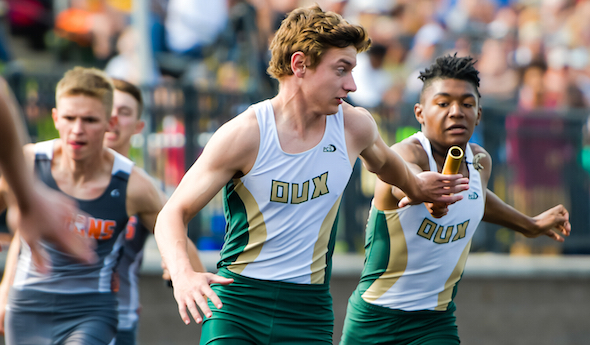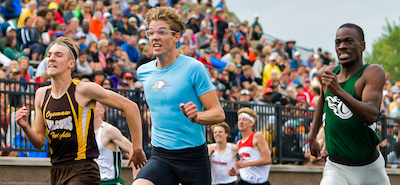
Storms Can't Squash Inspired Performances
June 1, 2019
By Matt Schoch
Special for Second Half
ZEELAND – From great-grandparents and former coaches to a mother and a son, athletes at the MHSAA Boys Track & Field Finals became champions in honor of their loved ones on Saturday.
Take senior Emari O’Brien of Harper Woods Chandler Park, who became the 100-meter Division 2 champion at 10.97 seconds at Zeeland Stadium in honor of former coach Paul Zelmanski, who died in January.
“This whole time I’ve been running, he told me I was going to win it one year,” said O’Brien, a Ferris State football signee who wrote “For Z” on his shoes. “Last year when I (took second place), he said next year when you come back, you’re going to win it for sure.
“I’ve been waiting on this for the longest time, so I have to win that for my coach.”
Athletes like O’Brien endured a three-and-a-half-hour delay and then another of 45 minutes as storms crept off Lake Michigan. Then, a final delay of more than two hours pushed the event to a 12-hour affair.
On the heels of three event wins, Zeeland West earned the team title with 53 points, topping Yale (37), Fruitport (33), Dearborn Divine Child (27) and Corunna (26).
“That means we have won every meet we have been to,” said Zeeland West’s Ethan Brooks, the only individual champion for the Dux. “It is awesome.”
Zeeland West won the 400 relay at 43.51 seconds, and the 800 relay at 1:29.29.
Brooks won the 300 hurdles at 39.38, edging Fruitport junior Ethan Flores by one hundredth of a second in his quest for a second title on the afternoon. Meanwhile, Flores said he had his family, in particular his great-grandmother, on his mind in the starting blocks for the 110 hurdles, which he won at 14.53 seconds. This, despite a slow start to his spring after basketball season leaked longer than usual.
“I didn’t have time to be at the track like I should’ve,” Flores said. “I worked by myself over Memorial Day. I wanted it, and I worked really hard for it.”
 Saginaw senior Tony Martin, who is headed to Michigan State, jumped 22-11.25, winning his second straight Division 2 title. That distance came, he said, despite missing the whole board on the championship jump.
Saginaw senior Tony Martin, who is headed to Michigan State, jumped 22-11.25, winning his second straight Division 2 title. That distance came, he said, despite missing the whole board on the championship jump.
Martin credited his mother, Kishon, for pushing him through hard times this year, including a pulled hamstring that hampered his season. He also said his son, Isaiah, has been an inspiration.
Before the injury, Martin had a regular-season jump of 26-6, which is among the top all-time national jumps.
“For me to come and do what I did is pretty amazing,” Martin said. “I’m just happy that I’m back and healthy.”
Junior Dylan Targgart of Coldwater continued his decorated career with two more titles, repeating in the discus at 187-7, a personal record, and the shot put at 66-7.50, a Division 2 Finals record, breaking former Detroit Lions defensive lineman Anthony Zettel’s 2011 mark for Ogemaw Heights (61-8).
“I had thrown my PR before the delay, so I think maybe it was a good thing since other people had to sit and wait and try and PR after that,” Targgart said. “So it might’ve worked to my advantage that way.”
Targgart is probably just being modest though – he won that competition by 14 feet and then the shot by more than six.
Rounding out the field events, junior Matt Veneziano of Parma Western won the high jump at 6 feet, 6 inches, and senior Josh DeVries of Grand Rapids South Christian won the pole vault at 15 feet.
On the track, junior Luke Brenner of Ada Forest Hills Eastern won the 200 at 22.02 seconds. Yale senior Justin Kudera won the 400 at 48.74 seconds, edging last season’s champion Jacob Denison of Tecumseh by six hundredths of a second.
Otsego junior Hunter Hartman won the 800 at 1:55.56; and Corunna senior Ben Jacobs won the 1,600 meters at 4:19.79.
Jacobs also overcame a Zeeland West runner to give Corunna a win in the 3,200 relay at 7:53.20.
After the final weather delay, Dearborn Divine Child junior Anthony Hancock won the 3,200 at 9:06.65.
Yale closed the long day with the 1,600 relay win in 3:23.42 to earn second overall.
PHOTOS: (Top) Zeeland West completes a relay hand-off during its team championship run Saturday. (Middle) Runners take off to start a race at Zeeland Stadium. (Photos by Kevin Fowler. Click to see more from RunMichigan.com.)

Track Gaining Speed Toward Future with Electronic Starting Devices
By
Steve Vedder
Special for MHSAA.com
May 23, 2023
Aubrey Greenfield thinks it might be the perfect time to reevaluate 130 years of tradition.
For a number of reasons, from technical to personal, the Oxford senior sprinter believes it makes sense for the crack of a starting pistol to be eliminated from high school track meets.
Because track meets would benefit in various ways from lowering costs to easier setup at meets to the human factor of competitors not having to flinch at the crack of a pistol shot, Greenfield believes the sport has a chance to embrace new technology – electronic starting devices (ESD).
In essence, an ESD replaces the starting pistol with a light flash, tone sound or both to begin a race.
"High school sports should put the athlete first," Greenfield said. "We should promote sports, and eliminating starting pistols promotes health in terms of PTSD or trauma for athletes and spectators and that would be good. I would like to think people would say that's a good idea."
In fact, Greenfield would go as far as to say if there was not an implementation of electronic starting devices, many of her teammates would have considered giving up the sport.
"If it's something that helps us compete safely, we're all for it," she said.
Greenfield's opinion apparently is spreading. Michigan High School Athletic Association senior assistant director Cody Inglis said the use of ESD makes it both affordable for meet starters and sensible for athletes and fans to rethink the use of starting pistols. While the MHSAA is not mandating electronic starting devices, it does promote the use of what Inglis calls "emerging technology." He notes that ESD are becoming the norm for organizations such as USA Track & Field, the NCAA and an increasing number of high schools.
 "I think we have to embrace new technology, and we think this will be something that takes hold," Inglis said.
"I think we have to embrace new technology, and we think this will be something that takes hold," Inglis said.
A key part of embracing ESD is the human element. The tragic Oxford High School shooting Nov. 30, 2021, that took the lives of four students while injuring seven others should not be relived even for a fleeting instance at a high school sporting event. Oxford athletic director Tony DeMare said the school began using ESD at every meet, including the MHSAA Lower Peninsula Division 1 Finals last June. He said that decision was embraced by virtually all schools Oxford encountered.
"We were very convinced that the alternative (of ESD) would promote a healthy attitude," DeMare said. "We were overwhelmed with the positive response. If a school was on the fence about it or might not be for it, I think we've started to see the tide turn in favor of people willing to listen and learn about electronic starting devices."
Inglis said the MHSAA is acutely aware of what the crack of a starting pistol can mean to athletes and fans.
"It's unimaginable what Oxford went through, and this is a small way we can help," he said. "We look at a (starting pistol) and think, ‘Could we do something else?’ It's a way of helping to solve a problem."
Over the last several years, the MHSAA has embraced finding an alternative to starting pistols. Inglis noted the discussion started with the cost and diminishing availability of 32-caliber ammunition that meet starters use. A box of ammunition, if it can be found, is around $75 a box.
In addition to cost, there is potential damage from excessive exposure to 150-plus decibels of sound generated by the traditional 32-caliber blanks. Medical studies show damage to ears caused by decibel levels above 120 dB.
The tragedy at Oxford accelerated the conversation.
Inglis said the cost of ESD can be likened to a school sinking money into artificial surfaces at football fields. Yes, there is a great cost at first, but over time money is ultimately saved. An ESD system itself ranges between $200 and $500. Speakers also may need to be purchased, but with ESD starting events like the 800 and 1,600-meter relays positioned near the outside lanes 8, 7, 6 and 5 would result in improved hearing by athletes at the start of a race.
There is one challenge with ESD that track administrators are working to overcome – lighting conditions that lessen the ability to see the ESD’s LED light or strobe when the button is pressed by a starter to begin a race. But that vision difficulty resulting from clear blue skies and backgrounds of setting suns can be substantially improved by incorporating a black background with an ESD – something as simple as a starter holding up black cardboard behind the lighting mechanism at the start of an event.
Inglis said when all factors are considered, the use of ESD makes sense.
 "With the climate we live in nowadays, no lookalike guns is good," he said. "We're not mandating this. But people are saying this is affordable."
"With the climate we live in nowadays, no lookalike guns is good," he said. "We're not mandating this. But people are saying this is affordable."
While switching to ESD would break 130 years of tradition, the timing could be a step forward, said Jeff Hollobaugh, co-author of the book "The Fleet Feet of Spring: Michigan's High School State Championships in Track & Field." He said while no definitive answer is possible, it's likely starting pistols were used at the inaugural state meet at the Jackson Fairgounds in 1895. The meet, which included events like tossing a 16-pound shot put, bike races and a 100-meter sprint, was sponsored by the Michigan Interscholastic Athletic Association (a predecessor to the MHSAA) and comprised mostly of the state's larger schools.
Hollobaugh's sentiments echo what many involved in today's high school track & field believe in terms of making a transition from starting pistols to electronic starting devices.
"It's a change, not necessarily good or bad, just different," he said. "It's not a drastic change, but it will take some getting used to. But it is the future. In the end, we'll all be fine."
DeMare believes the future of high school track will definitely include ESD.
"Our desire is that the practicality and sensibility of this will overcome the alternative," he said. "I think we'll see the automation and electronics taking hold of certain elements in track, and people will embrace it."
PHOTOS (Top) Runners watch official Bertha Smiley as they prepare to begin a race during last season's Lower Peninsula Division 1 Finals at Rockford. (Middle) An electronic starting device provided by VS Athletics was used to start those races. (Below) Smiley sets to begin an event. (Photos provided by David Kuderka/VS Athletics.)

